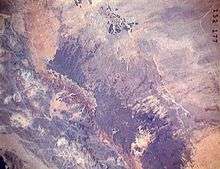Al Harrah, Saudi Arabia
Al Harrah (Arabic: ٱلْحَرَّة, romanized: Al-Ḥarrah) is a large basaltic volcanic field in northwestern Saudi Arabia near the Jordanian border. It covers an area of 15,200 km2. The volcanic field forms the southern third of the massive Harrat al-Shamah (also known as Harrat ash-Shaam) volcanic field, which extends from Syria through Jordan into northern Saudi Arabia. It is in the Tabuk Region of northwest Saudi Arabia.[1][2] It is one of a series of Quaternary volcanic fields paralleling the Red Sea coast.

The Saudi Arabian portion of the Harrat Ash Shamah volcanic field extends across a 210 km (130 mi)-long, roughly 75 km (47 mi)-wide NW-SE-trending area on the NE flanks of the Sirhan Valley and reaches its 1,100 metres (3,600 ft) high point at Jabal Al-Amud.
Activity began during the Miocene; a younger eruptive stage, at the SE end of the volcanic field, occurred during the late-Pleistocene and Holocene.[3] It is known to have erupted in historic times.[4][5] Vegetation is characteristically open acacia shrubland with patches of juniper at higher altitudes[6]
References
- U.S. Geological Survey Professional Paper (U.S. Government Printing Office, 1989) pA152
- Geological Survey Professional Paper, Volume 560, Part 1 (U.S. Government Printing Office, 1989)
- H. Stewart Edgell, Arabian Deserts: Nature, Origin and Evolution (Springer Science & Business Media, 21Jul.,2006 ) p329-330
- Geological Survey Professional Paper. U.S. Government Printing Office. 1989. p. 153.
- Peter Vincent, Saudi Arabia: An Environmental Overview (CRC Press, 2008) p22.
- S.A. Ghazanfar, Vegetation of the Arabian Peninsula (Springer Science & Business Media, 1998) p 272.
.jpg)


